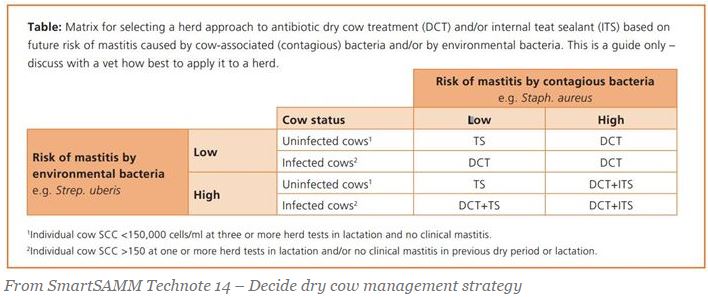



Making Dry Off Count: Combating Mastitis
Antibiotic dry cow treatments and internal teat sealants are 'valuable tools' to fight mastitis in high risk herds, New Zealand farmers are being told.Advice from DairyNZ includes a combinations of antibiotics and teat sealants for all cows in severe cases, with extra care needed at dry-off time.
Jane Lacy-Hulbert, DairyNZ senior scientist, considers protocols for high and low infections, focussing on dry-off time as a crucial period.
What’s Best For Your Herd?
Step 1 – decide your herd risk
Review cow somatic cell count (SCC) data, clinical mastitis records and any culture results with the vet. Together, assess the herd’s relative risk for environmental mastitis (bacteria from the environment) or contagious mastitis (bacteria spread from cow to cow at milking), as shown in the table below.
Herds with a high risk of environmental mastitis benefit from greater protection in the dry period, hence more use of ITS. Those herds with a high risk of contagious mastitis benefit from treating chronic cases at dry off, hence more emphasis on the use of DCT. These herds will also benefit from culling persistently-infected cows and preventing new cases in lactation by effective teat spraying.
Table: Matrix for selecting a herd approach to antibiotic dry cow treatment (DCT) and/or internal teat sealant (ITS) based on future risk of mastitis caused by cow-associated (contagious) bacteria and/or by environmental bacteria. This is a guide only – discuss with a vet how best to apply it to a herd.
Step 2 – decide herd and cow approach
Decide with the vet if all cows will be treated the same or differently. Cows considered likely to be infected or at risk of new infection should receive DCT.
Such cows include those with: no herd test or treatment records, a previous history of clinical mastitis , and/or one or more SCC above 150,000 cells/ml (heifers, above 120,000 cells/ml).
Treatment for all other cows will depend on herd management factors in the dry period. Work with the vet to decide the best treatments and make this drying off count. Drying off – make it smooth and safe Each year, herds get larger and more cows require treatment at drying off.
Below are some quick tips for streamlining the process and safeguarding the cows and team. Ten tips for drying off
- Dry off manageable mobs - Spread the task over a number of days or weeks to manage feed budgets and people. If transporting cows by truck and trailer immediately after dry off, set the group size by the number that can fit comfortably in a single truck/ trailer unit.
- Roster on extra staff - Work on the basis that one person can comfortably clean and treat about 15-20 cows per hour, for a maximum of two hours. A spare person to mark cows, hold tails, provide spare tubes and keep track of cows being treated is also invaluable.
- Use trained people - Your vet practice may offer vet technicians to help with drying off large mobs or offer training for farm teams as part of the Healthy Udder Service. Find out if your practice offers this service through Smartsamm.
- Choose dry days for drying off - Check the weather forecast before finalising dry off days and postpone for a day or two if it’s raining. Getting teats clean when the udder is dripping water is almost impossible and means a high risk of sick cows.
- Only treat cows once the rest of the herd is back in the paddock - Don’t start using dry cow antibiotics if milk is still going into the vat. Draft cows out and bring them back in when the pipe is disconnected. If doing a large mob, wash down the platform before bringing them back in, to reduce dirt being splashed onto cows’ teats.
- Follow MRS T - All treatments need to be recorded. Marking cows that need DCT is especially important if only parts of the herd are being dried off.
- Wear gloves - Gloved hands are much easier to keep clean, than ungloved hands.
- Clean immediately before treatment - Keep the time between cleaning a teat and treating it as short as possible, to avoid treating a dirty teat. Clean two teats at a time then treat them, before moving onto the other two teats. Work on the back teats first, then the front. This helps keep track of which teats have been treated.
- Work shoulder-to-shoulder - If splitting the cleaning and treating tasks across two people, make sure the cleaning person stays close, no more than one cow ahead of the treating person.
- Teat spray after treatment - Dedicate one person to do this task well and use freshly made up teat spray.



